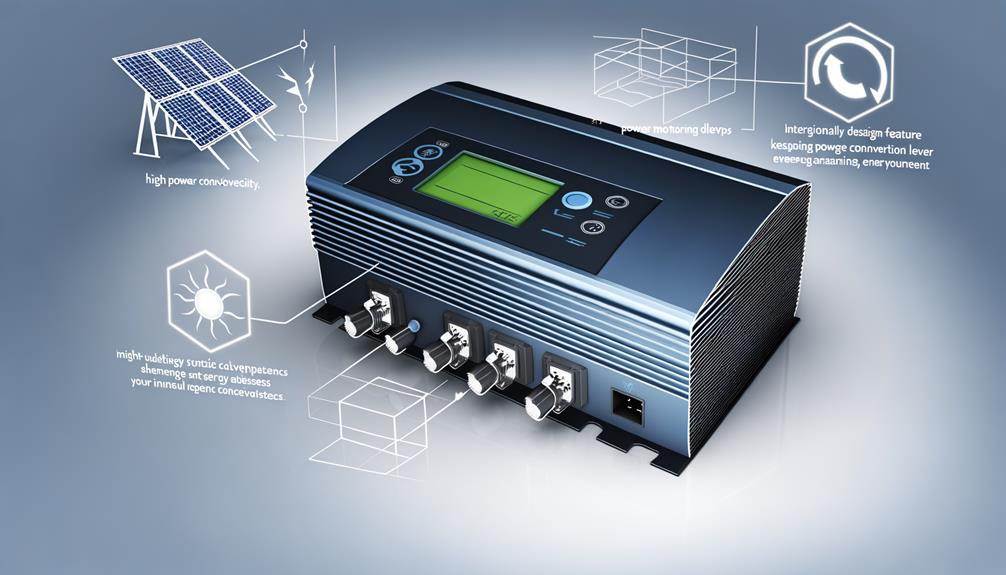Looking for the best all-in-one solar charge controller inverter? Look no further.
In a market flooded with options, finding the right one can be overwhelming. But fear not, because we’ve got you covered.
Whether you’re a seasoned solar power enthusiast or just starting out, this discussion will provide you with all the information you need to make an informed decision.
So, sit back, relax, and get ready to discover the best all-in-one solar charge controller inverter that will meet all your energy needs.
Key Takeaways
- High conversion efficiency ratings above 95% are essential for better energy conversion and overall system performance.
- Advanced MPPT technology allows for better tracking and utilization of available power, ensuring optimal efficiency even under varying weather conditions.
- Look for all-in-one charge controller inverters that are compatible with different battery types, as this enables optimized charging and extended battery life.
- User-friendly installation features, such as plug-and-play connectors or clear instructions, make the setup process easier and more convenient for users.
Best All In One Solar Charge Controller Inverters
Let’s discuss the best all-in-one solar charge controller inverters that are available in the market.
These include:
- ECO-WORTHY All-in-one Solar Hybrid Charger Inverter
- PowMr 6200W Solar Inverter
- PowMr 3000W Solar Inverter Charger
- OAE 6000W 48v Hybrid Solar Inverter
- SUNYIMA 60A MPPT Solar Charge Controller
These inverters offer a range of features such as LCD displays, multiple load control modes, and efficient power conversion. They are suitable for various off-grid solar power systems.
ECO-WORTHY All-in-one Solar Hybrid Charger Inverter
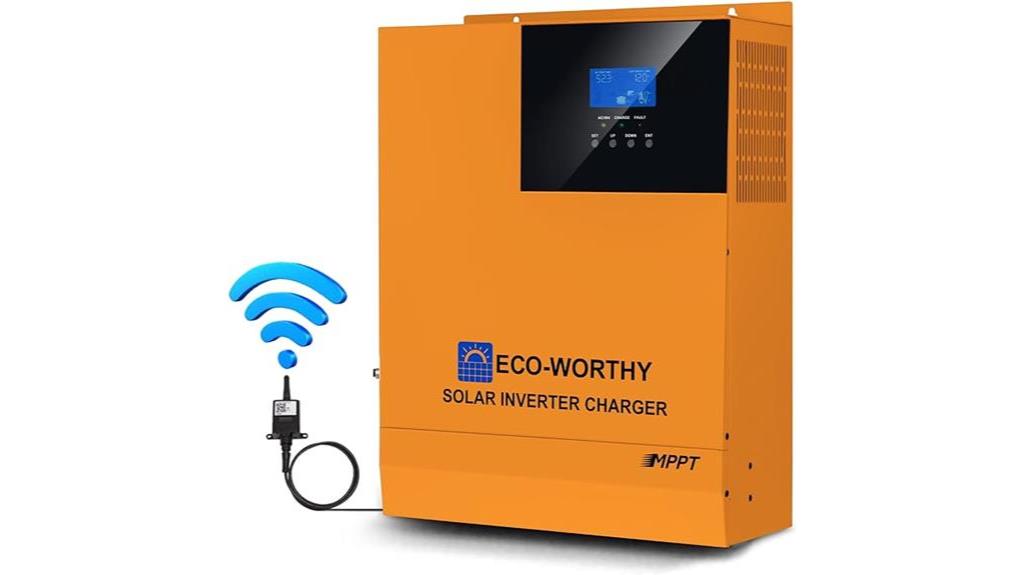
The ECO-WORTHY All-in-one Solar Hybrid Charger Inverter is the optimal choice for those seeking a high-performance and versatile solar charge controller inverter. This product features a built-in 3000W 24V Pure Sine Wave Power Inverter and a 60A MPPT Solar Controller. With multiple modes like mains bypass and inverter output, it provides uninterrupted power supply.
The MPPT technology with 99.9% efficiency ensures maximum power generation from your solar panels. The LCD screen and LED indicators display system data and operating status, making it easy to monitor. This all-in-one solar charge controller inverter also supports multiple battery types, including lithium and lead-acid. It offers multiple protection functions, such as short circuit, over/under voltage, overload, and reverse protection.
With its compact design and reliable performance, the ECO-WORTHY All-in-one Solar Hybrid Charger Inverter is a top choice for those looking for a high-quality and efficient solar charge controller inverter.
Best For: Those seeking a reliable and versatile solar charge controller inverter for uninterrupted power supply.
Pros:
- Built-in 3000W 24V Pure Sine Wave Power Inverter and 60A MPPT Solar Controller
- Multiple modes for mains bypass and inverter output
- LCD screen and LED indicators for easy monitoring of system data and operating status
Cons:
- Issues reported with overcharging batteries and lack of tech support
PowMr 6200W Solar Inverter 48V DC to 220-230VAC,Off-Grid All-in-One Charger Hybrid Inverter

For those seeking an all-in-one solar charge controller inverter that offers uninterruptible power support and combines the functions of inverter, solar charger, and battery charger, the PowMr 6200W Solar Inverter 48V DC to 220-230VAC is the ideal choice.
This off-grid all-in-one charger hybrid inverter features a 120A MPPT solar charge controller and a pure sine wave inverter with a single-phase output of 230VAC. With a maximum PV array power of 6500W and a maximum charging current of 120A, this inverter provides reliable power support. It also offers a cold start function and a wide PV array MPPT voltage range of 90-450Vdc.
The PowMr Hybrid Inverter LOGO displays different colors of RBG light to indicate the working mode. This versatile inverter is compatible with mains voltage or generator power and can be used for various household and office loads. It supports four charging modes, including utility first, solar first, solar and utility, and battery and solar.
Users have praised the PowMr 6200W Solar Inverter for its performance and recommend it for households with 4-5 persons. They also highlight the cost-saving benefits of the solar hybrid system and express satisfaction with the solution.
So, if you’re looking for an efficient and reliable all-in-one solar charge controller inverter, the PowMr 6200W Solar Inverter 48V DC to 220-230VAC is a great choice.
Best For: Those seeking an all-in-one solar charge controller inverter for households with 4-5 persons.
Pros:
- Offers uninterruptible power support
- Combines functions of inverter, solar charger, and battery charger
- Wide PV array MPPT voltage range
Cons:
- Requires a 48V DC input
PowMr 3000W Solar Inverter Charger 24V to 120V
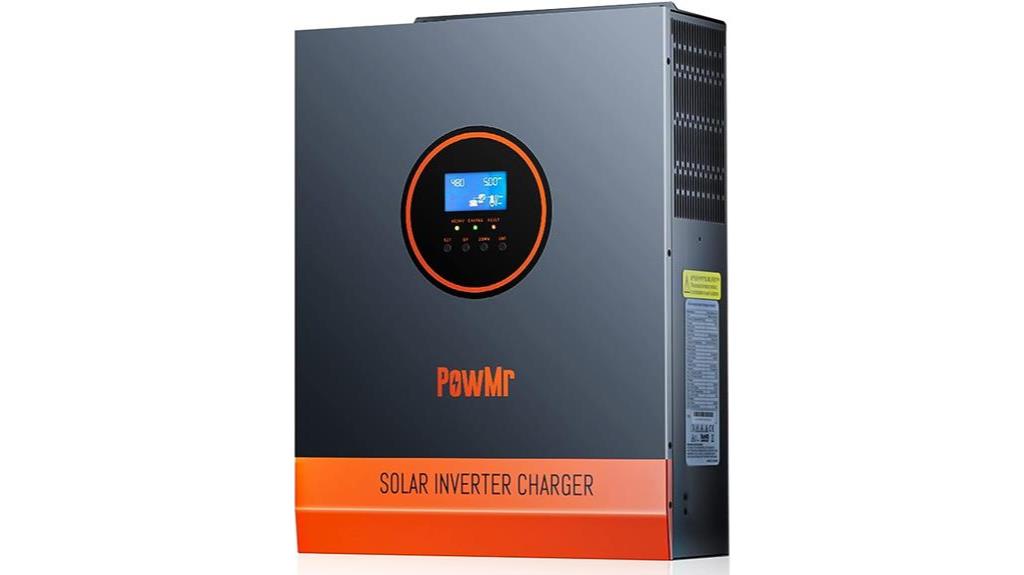
With its advanced MPPT technology, pure sine wave power output, and compatibility with both Lead Acid and Lithium batteries, the PowMr 3000W Solar Inverter Charger 24V to 120V is the optimal choice for those seeking a high-performance all-in-one solar charge controller inverter.
This solar inverter charger offers efficient charging capabilities thanks to its advanced MPPT technology. It also utilizes DC to AC advanced SPWM technology to provide a pure sine wave power output, ensuring a stable and reliable power supply. The LCD display and LED indicators allow for easy monitoring of system data and status.
The PowMr 3000W Solar Inverter Charger offers four optional charging modes, including solar, mains priority, solar priority, and mains & solar hybrid charging. With complete protections against short circuit, over/under voltage, overload, and reverse, you can have peace of mind knowing your system is well-protected.
Best For: Those in need of a high-performance all-in-one solar charge controller inverter with efficient charging capabilities and compatibility with Lead Acid and Lithium batteries.
Pros:
- Advanced MPPT technology for efficient charging
- Pure sine wave power output for stable and reliable power supply
- Four optional charging modes for flexible usage
Cons:
- Concerns about the advertised voltage and wire size recommendations
OAE 6000W 48v Hybrid Solar Inverter
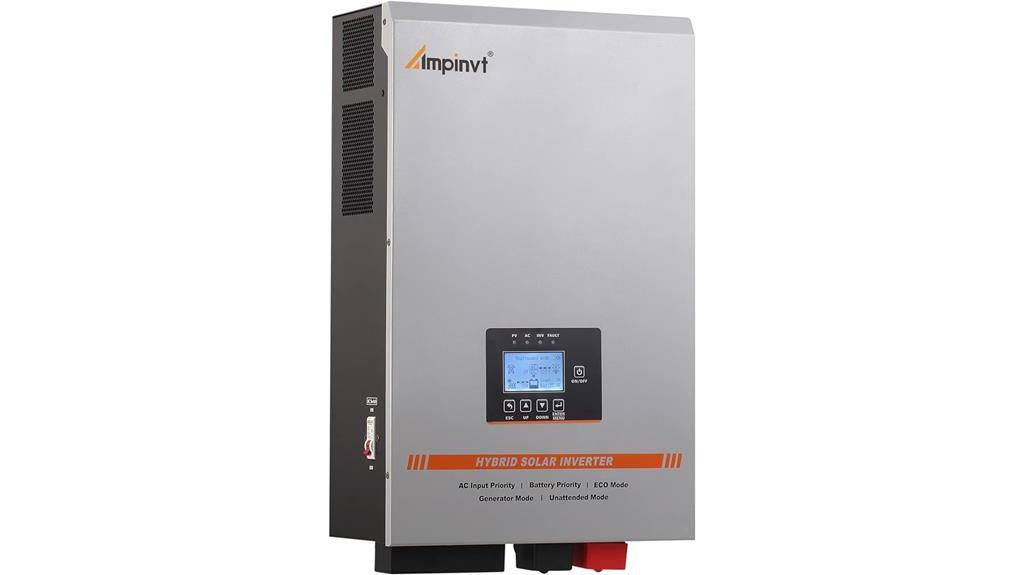
Optimize your solar power system with the OAE 6000W 48v Hybrid Solar Inverter, the ultimate all-in-one solution for efficient and versatile solar charge control and power conversion.
With a 120V/240V split phase output, this inverter offers a built-in 100A MPPT Solar Charge Controller, ensuring maximum energy capture from your solar panels. The off-grid low frequency pure sine wave inverter charger is compatible with lead-acid, lithium, and gel batteries, providing flexibility for different energy storage options.
Featuring high transfer efficiency above 85%, the OAE 6000W 48v Hybrid Solar Inverter guarantees optimal power conversion and utilization. It also comes with a built-in AVR stabilizer and surge interference protection, ensuring a stable and reliable power supply. With its impact resistance super load capacity and continuous stable pure sine wave output, this inverter is designed to handle various household appliances and electronics.
Furthermore, the OAE 6000W 48v Hybrid Solar Inverter offers multiple protection features, including overvoltage, low voltage, low battery alarm, high battery alarm, over-temperature, overload, short circuit, and backfeeding protection. This ensures the safety and longevity of your solar power system.
While the product has received positive feedback on its performance and ease of setup, some users have mentioned the need for larger battery and solar input terminals. There have also been reports of issues with the MPPT functionality affecting solar panel output and battery charging. Nonetheless, the OAE 6000W 48v Hybrid Solar Inverter remains a powerful and versatile option for optimizing your solar power system.
Best For: Users looking for an all-in-one solution for efficient solar charge control and power conversion.
Pros:
- High transfer efficiency above 85%
- Multiple protection features for safety and longevity
- Compatible with various battery types and PV inputs
Cons:
- Users may need larger battery and solar input terminals
SUNYIMA 60A MPPT Solar Charge Controller with LCD Display Dual USB Multiple Load Control Modes
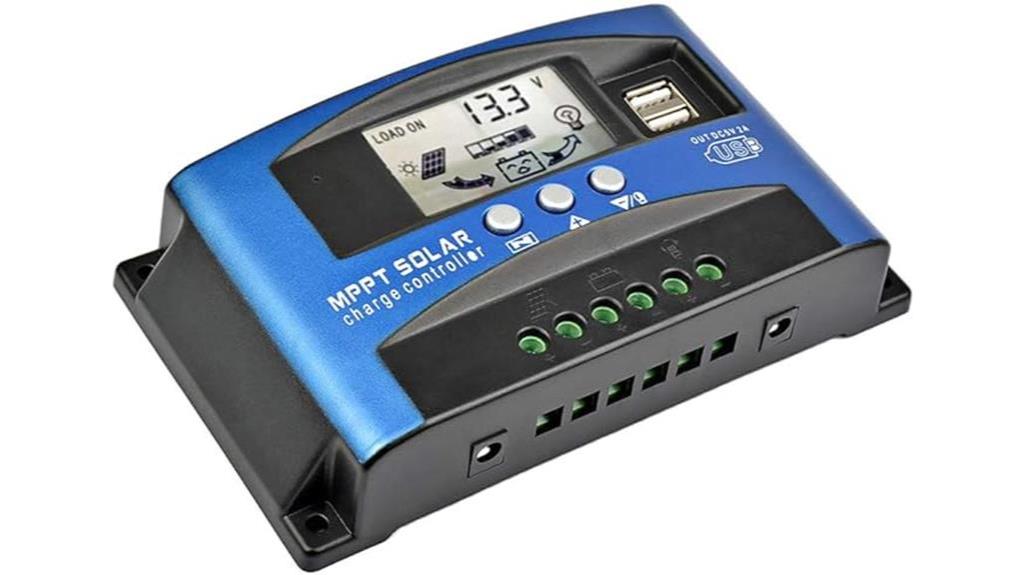
The SUNYIMA 60A MPPT Solar Charge Controller with LCD Display Dual USB Multiple Load Control Modes is the ultimate choice for those seeking a highly efficient and reliable all-in-one solar charge controller inverter. This controller utilizes innovative MPPT technology with a high tracking efficiency of up to 99%. Unlike other types of MPPT technology, it detects the maximum charging current, ensuring optimal performance.
The multi-function LCD display provides easy monitoring and control of your solar system. The controller is compatible with both 12V and 24V systems and automatically adapts to the battery type. It also offers reliable protection against overvoltage, short circuit, overload, overcharge, and over discharge.
With its industrial-grade master chip, it provides accurate real-time display of charging and discharge current. Choose the SUNYIMA 60A MPPT Solar Charge Controller for a hassle-free and efficient solar charging experience.
Best For: Those looking for a highly efficient and reliable solar charge controller with multiple load control modes.
Pros:
- Utilizes innovative MPPT technology with high tracking efficiency up to 99%
- Multi-function LCD display for easy monitoring and control
- Provides reliable protection against various electrical issues
Cons:
- Some users may find the instructions for setup and configuration confusing
Best All In One Solar Charge Controller Inverter Buying Guide
When looking to purchase the best all in one solar charge controller inverter, there are several important features to consider.
Efficiency and performance should be at the top of your list, as these factors will determine how effectively the device converts solar energy into usable power.
It’s also crucial to ensure that the controller inverter is compatible with your solar panels, allowing for seamless integration and optimal performance.
Additionally, consider the battery charging options and power output capacity to meet your specific energy needs.
Features to Consider
Consider key features when selecting an all-in-one solar charge controller inverter. Efficiency comparison is crucial as it determines how effectively the device converts solar energy into usable power. Look for high-efficiency models that maximize energy conversion and minimize losses.
Battery compatibility is another essential factor to consider. Ensure that the inverter is compatible with your battery type to optimize charging and extend battery life.
Additionally, consider installation tips to ensure a smooth and hassle-free setup. Look for inverters that offer user-friendly installation features such as plug-and-play connectors or clear installation instructions. This will save you time and effort during the setup process.
Efficiency and Performance
To ensure optimal efficiency and performance when selecting the best all-in-one solar charge controller inverter, prioritize models that maximize energy conversion and minimize losses.
Improving efficiency is crucial for maximizing output and optimizing performance. Look for models that have high conversion efficiency ratings, typically above 95%, as this indicates that the inverter can convert a higher percentage of the solar energy into usable electricity.
Additionally, consider inverters that incorporate advanced MPPT (Maximum Power Point Tracking) technology, which allows for better tracking and utilization of the maximum available power from the solar panels. This technology ensures that the inverter operates at its peak efficiency, even under varying weather conditions.
Compatibility With Solar Panels
For optimal compatibility with solar panels, it’s essential to choose an all-in-one solar charge controller inverter that seamlessly integrates with a wide range of panel types and configurations.
Different solar panels may have different voltage outputs, so it’s important to ensure that the charge controller inverter can handle the specific voltage range of your panels.
To maximize solar panel efficiency, the charge controller inverter should be capable of handling the voltage compatibility of the panels.
Additionally, consider the panel positioning. Some all-in-one charge controller inverters are designed to work efficiently with panels positioned at various angles, such as flat on the roof or tilted. This flexibility allows for optimal sunlight exposure and increased energy generation.
Battery Charging Options
A crucial aspect to consider when choosing the best all-in-one solar charge controller inverter is the availability of various battery charging options.
Different battery types for solar charging offer different advantages and drawbacks. Lithium-ion batteries, for example, are lightweight, have a longer lifespan, and higher energy density. On the other hand, lead-acid batteries are more affordable and widely available.
With the use of a battery charge controller, you can ensure that your battery is charged efficiently and safely. These controllers regulate the flow of power from the solar panels to the battery, protecting it from overcharging or discharging. However, using a battery charge controller may introduce some inefficiency due to energy losses.
To maximize battery life with solar charging, it’s important to properly size the system, avoid deep discharging, and maintain the battery at an appropriate temperature.
Power Output Capacity
The power output capacity is a key consideration when selecting the best all-in-one solar charge controller inverter. It determines the amount of electricity that can be generated and used for various purposes.
To ensure optimal performance, it’s important to match the power output capacity of the inverter with the battery capacity and load requirements. The battery capacity refers to the amount of energy that can be stored in the battery, while solar panel efficiency affects the amount of electricity that can be generated from sunlight.
The load capacity represents the maximum amount of power that the inverter can supply to connected devices. By carefully considering these factors, you can choose an all-in-one solar charge controller inverter that meets your power needs and ensures efficient energy utilization.
Related Post: The Best 10 DIY Solar Panel Kits for Off-Grid Power.
Monitoring and Control Capabilities
To ensure efficient energy management, an all-in-one solar charge controller inverter offers advanced monitoring and control capabilities. With remote monitoring capabilities, you can easily keep track of your solar system’s performance from anywhere in the world.
This allows you to stay informed about the energy production and consumption in real time, enabling you to make informed decisions to optimize your system’s efficiency. The advanced control features provide you with the ability to adjust settings and parameters according to your specific energy needs.
With real-time data analysis, you can analyze the performance of your solar system and identify any issues or inefficiencies that may arise. This empowers you to take immediate action and ensure the optimal functioning of your solar power system.
Protection and Safety Features
With a focus on ensuring the utmost protection and safety, the best all-in-one solar charge controller inverter offers a comprehensive range of features designed to safeguard your solar power system.
One of the key safety features is battery protection, which prevents overcharging and over-discharging of the batteries. This not only extends the lifespan of your batteries but also ensures optimal performance.
Another important feature is overload protection, which safeguards your system from excessive current or power demands. It automatically disconnects the system in case of overload, preventing any damage to your equipment.
Additionally, the best all-in-one solar charge controller inverter includes lightning protection, which protects your system from damage caused by lightning strikes. This feature redirects the lightning current safely to the ground, ensuring the safety of your system and the connected devices.
Installation and Setup Process
You can easily install and set up the best all-in-one solar charge controller inverter with the help of these step-by-step instructions.
During the installation and setup process, there are common challenges that you may encounter. One of these challenges is ensuring the proper alignment and mounting of the solar panels. It’s important to position the panels in a way that maximizes sunlight exposure.
Additionally, connecting the various components, such as the solar panels, battery, and inverter, can be a challenge. To troubleshoot these installation issues, double-check all connections and consult the user manual for specific instructions.
Once the installation is complete, proper maintenance is crucial to ensure the longevity and optimal performance of the system. This includes regularly cleaning the solar panels, checking for any loose connections, and monitoring the battery voltage levels.
Warranty and Customer Support
The warranty and customer support for the best all-in-one solar charge controller inverter ensures peace of mind and assistance throughout the lifespan of your system.
When selecting the right product, it’s crucial to consider the level of customer satisfaction, warranty coverage, and technical support offered by the manufacturer.
A comprehensive warranty provides protection against any potential defects or malfunctions in the product. Look for a warranty that covers both the hardware and software components of the solar charge controller inverter.
Additionally, a reputable manufacturer will offer reliable customer support to address any inquiries or issues that may arise during the installation or operation of the system. This includes assistance with troubleshooting, firmware updates, and general technical guidance.
Prioritize a product that offers excellent warranty coverage and reliable technical support to ensure a smooth and hassle-free experience with your solar charge controller inverter.
Price Range and Value
For those seeking the best all-in-one solar charge controller inverter, finding a product that offers a competitive price range and exceptional value is essential. When it comes to price comparison, it’s important to consider both the upfront cost and the long-term savings.
Look for a product that not only fits your budget but also provides high-quality performance and durability. To ensure you make an informed decision, take the time to read customer reviews. These can offer valuable insights into the product’s reliability and performance.
Additionally, consider the warranty options available. A longer warranty period can provide peace of mind and protect your investment.
Building Your Own All-In-One Solar Power System
Building your own all-in-one solar power system can be a cost-effective and efficient solution for off-grid energy needs. The building process allows for system customization according to your specific requirements.
Compared to buying individual parts and assembling them yourself, building your own system can save you money. It’s also easy to assemble, taking only an hour to set up. These all-in-one systems are compatible with different battery types and can be programmed easily. They offer high efficiency, often measuring at 96%, making them a cost-effective option.
However, it’s important to consider the cons, such as high idle consumption and limitations in terms of grid connectivity.
Related Post: DIY Off-Grid System: The Ultimate Guide to Power Your Paradise.
Final Verdicts
To evaluate the overall effectiveness of building your own all-in-one solar power system, it’s important to analyze its performance and consider any potential drawbacks.
When it comes to battery lifespan, an all-in-one solar charge controller inverter can provide efficient charging and discharging capabilities, ensuring the longevity of your batteries.
Solar panel efficiency is another crucial factor to consider. With advancements in technology, all-in-one systems now offer high-efficiency solar panels that can convert more sunlight into usable energy.
Lastly, remote monitoring capability is a key feature that allows you to monitor and control your system from a distance. This feature provides convenience and peace of mind, as you can easily track the performance of your system and make adjustments as needed.
Frequently Asked Questions
How Much Power Can an All-In-One Solar Charge Controller Inverter Generate?
An all-in-one solar charge controller inverter can generate a certain amount of power based on its power output limitations. The efficiency of these inverters and the impact of weather conditions are factors that affect power generation.
Can an All-In-One Solar Charge Controller Inverter Be Used for Both Residential and Commercial Applications?
An all-in-one solar charge controller inverter can be used for both residential and commercial applications. However, there are benefits and drawbacks to consider. Installation challenges may arise, but the convenience and cost savings make it a viable option.
What Are the Key Factors to Consider When Choosing an All-In-One Solar Charge Controller Inverter?
When choosing an all-in-one solar charge controller inverter, consider factors such as power capacity, efficiency, compatibility with your solar panel system, and additional features like monitoring and protection capabilities.
Is It Possible to Expand the Capacity of an All-In-One Solar Charge Controller Inverter System in the Future?
Yes, you can expand the capacity of an all-in-one solar charge controller inverter system in the future. It allows for future upgrades and has scalability, making it a reliable choice for your solar power needs.
Are There Any Additional Maintenance or Servicing Requirements for All-In-One Solar Charge Controller Inverters?
To ensure the longevity and durability of your all-in-one solar charge controller inverter, regular maintenance and servicing are required. This includes troubleshooting and diagnostics to identify and address any issues that may arise.

